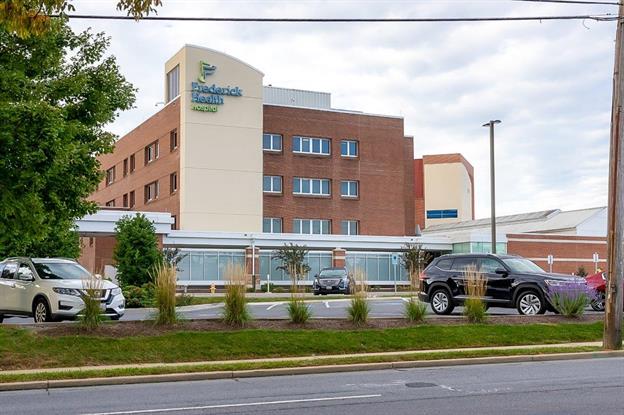Interventional Cardiology
Interventional cardiologists are the physician specialists who perform diagnostic cardiac catheterizations and emergency angioplasty procedures to treat emergency heart attack patients. Frederick Health's interventional cardiologists have collectively performed thousands of these procedures.
Cardiac Catheterization
Cardiac catheterization (also called cardiac cath or coronary angiogram) is a procedure that allows your doctor to "see" how well your heart is functioning. The test involves inserting a long, narrow tube, called a catheter, into a blood vessel in your arm or leg, and guiding it to your heart with the aid of a special X-ray machine. Contrast dye is injected through the catheter so the physician can see X-ray-generated video of your valves, coronary arteries and heart chambers.
Why Do I Need a Cardiac Catheterization?
Your doctor uses cardiac cath to:
- Evaluate or confirm the presence of heart disease (such as coronary artery disease, heart valve disease, or disease of the aorta).
- Evaluate heart muscle function.
- Determine the need for further treatment (for example, angioplasty or bypass surgery)
How Should I Prepare for Cardiac Catheterization?
- Most people will need to have a routine chest X-ray , blood tests and an electrocardiogram performed no less than 2 weeks before the procedure.
- You can wear whatever you like to the hospital. You will wear a hospital gown during the procedure.
- Leave all valuables at home. If you normally wear dentures, glasses, or a hearing assistance device, plan to wear them during the procedure.
- Your doctor or nurse will give you specific instructions about what you can and cannot eat or drink before the procedure.
- Ask your doctor what medications should be taken on the day of your test. You may be told to stop certain medications, such as Coumadin (warfarin, a blood thinner).
- If you have diabetes, ask your doctor how to adjust your medications the day of your test.
- Tell your doctor and/or nurses if you are allergic to anything, especially iodine, shellfish, X-ray dye, latex or rubber products (such as rubber gloves or balloons) or penicillin-type medications.
- You may or may not return home the day of your procedure. Bring items with you (such as robe, slippers and toothbrush) to make your stay more comfortable. When you are able to return home, arrange for someone to give you a ride and stay with you overnight for the first night.
How Long Does the Procedure Last?
The catheterization procedure usually takes about 30 minutes, but the preparation and recovery time add several hours. Plan on being at the hospital all day for the procedure.
What Happens During the Procedure?
You will be given a hospital gown to wear. A nurse will start an intravenous (IV) line in your arm so that medications and fluids can be administered through your vein during the procedure.
The cardiac catheterization room is cool and dimly lit. You will lie on a special table. If you look above, you will see a large camera and several TV monitors. You can watch the pictures of your cardiac cath on the monitors.
The nurse will clean (and possibly shave) the site where the catheter will be inserted (arm or groin). Sterile drapes are used to cover the site and help prevent infection. It is important that you keep your arms and hands down at your sides and not disturb the drapes.
Electrodes (small, flat, sticky patches) will be placed on your chest. The electrodes are attached to an ECG, which charts your heart's electrical activity.
You will be given a mild sedative to help you relax, but you will be conscious and may be awake during the entire procedure. The doctor will use a local anesthetic to numb the catheter insertion site.
If the catheter is to be inserted at the groin (called the "femoral" approach), a local anesthetic will be injected into a vein in your groin. A small incision will be made over the blood vessel through which the catheter and introducer sheath (a short, hollow tube through which the catheter is placed) is will be inserted. A catheter will be inserted through the sheath and threaded to the arteries of your heart. Although you may feel pressure as the incision is made or when the catheter is inserted, you should not feel pain - please tell your health care providers if you do.
When the catheter is in place, the lights will be dimmed and a small amount of dye (or "contrast material") will be injected through the catheters into your arteries and heart chambers. The contrast material outlines the vessels, valves and chambers.
When the contrast material is injected into your heart, you may feel hot or flushed for several seconds. This is normal and will go away in a few seconds. Please tell the doctor or nurses if you feel itching or tightness in the throat, nausea, chest discomfort, or any other symptoms.
The X-ray camera will be used to take photographs of the arteries and heart chambers. You will be asked to hold your breath while the X-rays are taken. When all the photos have been taken, the catheter will be removed and the lights will be turned on.
After your procedure you will be taken to the Interventional Unit. You will be asked to lie flat for several hours. Before leaving the hospital you will be given instructions about medications, physical activity and follow-up care.
Follow up Care
Frederick Health offers programs specifically designed for cardiac patients, use the links below to learn more.
-
Stroke Program
Our award-winning team is ready 24/7 to Act FAST and provide critical care to treat stroke.
Learn More -
ProMotion Fitness
Exercise is Medicine. Let us help you develop a fitness plan focused on your unique health needs.
Learn More



